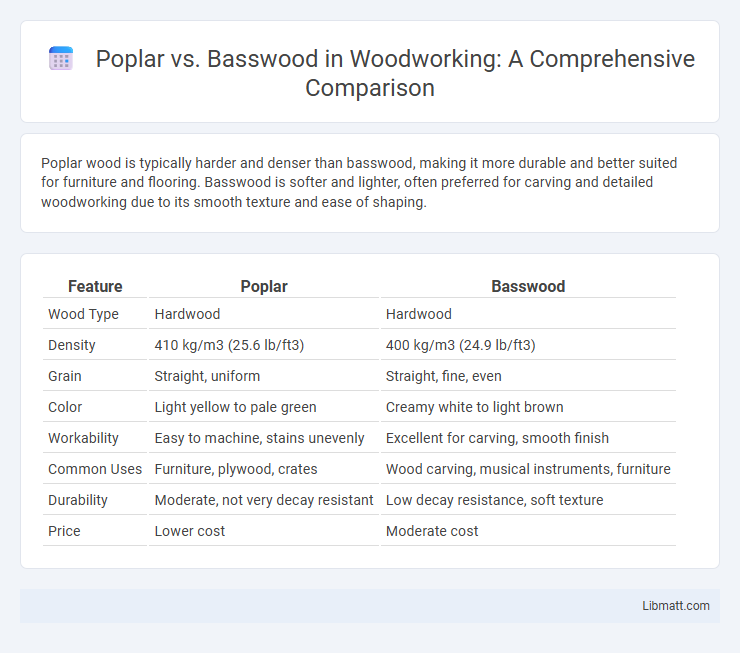Poplar wood is typically harder and denser than basswood, making it more durable and better suited for furniture and flooring. Basswood is softer and lighter, often preferred for carving and detailed woodworking due to its smooth texture and ease of shaping.
Table of Comparison
| Feature | Poplar | Basswood |
|---|---|---|
| Wood Type | Hardwood | Hardwood |
| Density | 410 kg/m3 (25.6 lb/ft3) | 400 kg/m3 (24.9 lb/ft3) |
| Grain | Straight, uniform | Straight, fine, even |
| Color | Light yellow to pale green | Creamy white to light brown |
| Workability | Easy to machine, stains unevenly | Excellent for carving, smooth finish |
| Common Uses | Furniture, plywood, crates | Wood carving, musical instruments, furniture |
| Durability | Moderate, not very decay resistant | Low decay resistance, soft texture |
| Price | Lower cost | Moderate cost |
Overview of Poplar and Basswood
Poplar and basswood are both lightweight hardwoods commonly used in woodworking and crafting due to their easy machinability and smooth finish. Poplar typically has a straight grain with a pale yellow to light green hue, making it ideal for painted projects, while basswood features a fine, even texture with a pale cream color, favored for carving and detailed work. Your choice between poplar and basswood should consider the specific project requirements, including durability, workability, and aesthetic preferences.
Botanical Characteristics
Poplar and basswood trees belong to different botanical families--Poplar is part of the Salicaceae family, while basswood falls under Malvaceae. Poplar species typically have triangular or ovate leaves with serrated edges and grow rapidly, often reaching heights of 50 to 165 feet. Basswood features broad, heart-shaped leaves and dense wood fibers, supporting its slower growth and making it highly valued for carving and fine woodworking.
Wood Color and Grain Differences
Poplar wood typically features a pale yellow to light greenish hue with straight grain patterns, offering a smooth and uniform texture ideal for painting and finishing. Basswood, on the other hand, displays a creamy white to light brown color with a fine, even grain that enhances detailed carving and a clean appearance. When choosing between the two, consider your project's aesthetic needs, as Poplar's subtle color variations provide character while Basswood's consistent tone ensures a refined, smooth finish.
Hardness and Durability Comparison
Poplar wood has a Janka hardness rating of approximately 540, making it moderately soft but more durable than basswood, which rates around 410. Basswood is softer and more prone to dents and scratches, commonly used for carving and delicate work due to its fine grain and low hardness. Poplar offers better resistance to wear and impact, making it more suitable for furniture and flooring applications where durability is essential.
Workability for Woodworkers
Poplar offers superior workability with its fine, even texture and moderate hardness, making it ideal for intricate woodworking projects and easy sanding or painting. Basswood is softer and lightweight, favored for carving and detailed craftwork due to its minimal grain and smooth finish. Your choice between poplar and basswood should depend on whether you prioritize durability or ease of carving for your woodworking tasks.
Common Uses in Furniture and Crafts
Poplar wood is favored in furniture and crafts for its affordability, smooth finish, and ease of painting or staining, making it ideal for cabinets, shelves, and painted furniture pieces. Basswood, valued for its fine grain and softness, is commonly used in detailed carving, model making, and musical instruments due to its lightweight and smooth texture. When choosing between the two, your project's need for durability versus fine detail will determine whether poplar's strength or basswood's workability is more suitable.
Cost and Availability
Poplar is generally more affordable and widely available compared to basswood, making it a preferred choice for budget-conscious woodworking projects. Basswood, while slightly more expensive, offers a finer, more consistent grain but can be less common in some regions. Your decision may depend on balancing cost efficiency with the specific availability of each wood type in your local market.
Environmental Impact and Sustainability
Poplar and basswood both offer sustainable options due to their fast growth rates and ability to regenerate quickly, reducing deforestation pressure. Poplar trees are often grown in managed plantations with high carbon sequestration capacity, making them environmentally beneficial for reforestation projects. Basswood, known for its minimal chemical treatment requirements and biodegradability, contributes to lower environmental impact in woodworking and manufacturing processes.
Pros and Cons of Poplar
Poplar offers a lightweight and affordable hardwood option with a smooth grain that takes paint well, making it ideal for furniture and cabinetry projects. However, it is softer and less durable than other hardwoods like basswood, making it more prone to dents and scratches. While poplar is less expensive, it has a limited natural color range, often requiring staining or painting for aesthetic appeal.
Pros and Cons of Basswood
Basswood offers a lightweight, soft texture ideal for detailed carving and crafting but tends to lack durability compared to harder woods like poplar. Its fine, even grain resists splitting and provides a smooth surface for painting or finishing, making it popular among artisans and model makers. However, basswood's softness makes it prone to dents and less suitable for heavy structural applications or outdoor use.
Poplar vs basswood Infographic

 libmatt.com
libmatt.com